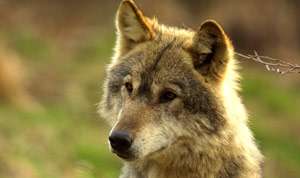
Crai ("King"), a 7-year-old male, is one of the CLCP's two captive wolves, which are kept for educational purposes.
While Romania is clearly not a part of the territory we normally cover, we believe that the writer’s observations in this article are relevant to the ongoing debate about the role that large carnivores could play here in the forests of the Northeast. In the accompanying story, “Is the Wolf at the Door?,” that relevance is more explicit. -The Editors
Sitting on rigid benches in the stark, cold classroom, bundled in their winter coats and hats, the small group of sixth-graders listens attentively as Simona Buretea describes ways to publicize the presentation they will give to the village community next week. The meager heat from the single woodstove is lost in the immensity of the large, whitewashed classroom, which dwarfs the cluster of seven children. Hanging crookedly on the wall is a tattered map of the world, depicting nations that have not existed for half a century. Through the tall windows, which rattle and sing as gusts of wind seek entry through the loose fittings and cracked panes, can be seen the spectacular panoramic view that graces this small Transylvanian mountain village called Pestera (pronounced Pesh-TEAR-a). Farmhouses are scattered on rolling hillsides or perched precariously along the spines of ridges, seeming to hang in the thin, invisible air that blows cold from the snow-capped peaks beyond. As the students walk to school, which is an hour-and-a-half journey for some, their hearts quicken from more than just the exertion and the beauty of the scenery – for they hear stories.
Buretea is the public awareness officer for the Carpathian Large Carnivore Project (CLCP), a non-governmental organization that has conducted research in Romania on the behavior and ecology of wolves, bears, and lynx for almost 10 years in order to help conserve the unique natural heritage of the region. She has commissioned the students to investigate current stories of wolf attacks on people (including children) that circulate in the village. No computer or Internet is available to aid this task – the students must query their relatives and friends, discovering who told whom what, tracing the stories back, if possible, to the sources. They will report their findings in a presentation to which the community is invited.
The Carpathian Mountains of Romania, which cradle the Transylvania plateau like a giant arm, contain the most significant populations of large carnivores in all of Europe west of Russia. About 3,200 wolves (approximately 30 percent of the wolf population of Europe, excluding Russia), 5,400 European brown bears (50 percent of the population), and 1,500 Eurasian lynx (25 percent) live in the country, even though it has a relatively dense human population. With 22 million people residing in an area about 2.6 times the size of Maine, Romania is about 6.5 times more densely populated.
It is commonly believed in Romania that wolves are dangerous to humans. The fear is rooted in stories about wolf attacks that are told repeatedly until they become unverifiable folklore. An investigation of 41 such stories circulating within the country in the last half-century confirmed that eight were based on factual events. In each of those cases, the wolf was injured or rabid, or had been trapped or cornered and was defending itself from further attack by people or dogs (in at least one case, after trying to take a sheep). There were no unprovoked attacks and no serious injuries to humans, though one person had a month-long hospital stay as a precaution against rabies.
In the report that the sixth-grade students gave to their neighbors in Pestera, they told the rather boisterous audience that they were not able to verify any of the village wolf-attack stories. Some members of the audience were initially reluctant to hear that message, but as the discussion progressed, the villagers acknowledged that their fear of wolves was unjustified and they, in fact, had more problems with bears.
An ancient way of life
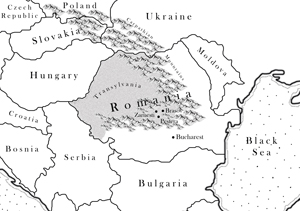
The Transylvania region lies cradled in the “arm”
formed by the Carpathian Mountains to the east
and the Transylvanian Alps to the south.
Until the fall of Romania’s Communist regime in 1989, effective conservation of large carnivores was due primarily to state authority, as Nicolae Ceausescu, the ruthless dictator, instituted rigorous wildlife protections. It is widely assumed that these measures were taken in order to enhance his personal bear-hunting success.
When the Communist regime fell, the protections ceased, and the large predators soon faced the same pressures that have decimated their numbers in most of the rest of Europe. In part to conform to European biodiversity and conservation goals, Romania restored legal protection to wolves and other predators in the mid-1990s, although enforcement is marginal. Still, the result is that Romania today is the large carnivore capital of Europe. The carnivores are tolerated despite the fact that Romania is a poor country with a fragile economy highly dependent on livestock. In 2002, the average per capita annual income was $1,850, and 45 percent of the population lived below the poverty level.
Agriculture accounts for 15 percent of the Romanian economy, employs about 40 percent of the labor force, and, in the Carpathians, not only provides a primary source of livelihood but also sets the rhythm for an ancient way of life. Rolling slowly along the country roads are horse-drawn carts carrying towering loads of hay or bundles of sticks for firewood or groups of peasants to work the fields. Cows, horses, goats, and sheep are still herded through the main streets of villages and towns, frustrating the drivers of cars rushing to meet their appointments in the hectic pace of the “new economy,” which is just beginning to challenge the ancient rhythms. Whether marching to the old rhythms or the new, it is the attitudes formed over centuries of coexistence and conflict with livestock that still dominate the feelings about wolves in Romania.
During winter, most sheep and other livestock are confined to the lowland villages and farms where dwell the hardy, rural people who depend upon and care for them. In early spring, the animals are allowed to graze the rich pastures of the valleys, and then, in late May, they are gathered into larger flocks – numbering up to a thousand animals – and led up to the high summer pastures in the mountains. There the shepherds live with the flocks for the duration of the summer in “shepherd camps,” where for income they make cheese from the animals’ milk.
Wolves and bears prey on unprotected livestock, and in Romania they take about 1.2 percent of the five million sheep that graze within their territory each year (a much higher rate than is typical in the U.S.). This loss is a significant economic burden to people so dependent on livestock for their livelihood; yet, although some poaching of wolves does occur, the unrelenting campaign that led to their eradication in the U. S. has not occurred in Romania.
Of course, the shepherds do work hard to protect their flocks, and large, aggressive shepherd dogs are their primary tool. Although the dogs may directly fend off attacks, barking is usually their most effective function, as wolves will not challenge humans who are alert to their presence. Nevertheless, the predators are sometimes successful, relying on stealth and speed – and, often, negligent shepherd dogs.
The CLCP has developed and tested new methods for protecting livestock. Portable electric fences that surround the sheep pens at night have eliminated livestock losses in the camps. The project also recommends better training and nutrition for the guard dogs, as their typical inexpensive, corn-based diet lacks sufficient protein, motivating them to hunt for prey instead of protecting the flocks.
Tracking the predators
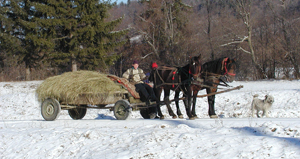
Local transportation in April, near Zarnesti, Transylvania region,
Romania. Wolves, bears, and lynx inhabit these woods, which
consist primarily of beech, spruce, and fir. Small dogs often seem
to lead horse cart expeditions between village and countryside.
In March 2003, I assisted the CLCP as it conducted a predation study, wherein a team of biologists, students, and volunteers intensively monitored a radio-collared female wolf and her male pack-mate in order to determine the content and quantity of their diet over a 30-day period.
At night, when the wolves are most likely to hunt, their location and activity was continuously monitored via radio signals transmitted by the collar. Locating wolves using radio-telemetry is as much an art as a science, especially in the very rough, mountainous terrain of Transylvania. The topography can distort the signals, and the task is often further complicated by snowstorms, frozen hands, stuck vehicles, suspicious forestry officials, or rapidly moving wolves.
Predation results are discovered during the day, when fresh tracks can be followed in the snow (usually backtracking from the kill site). Many long, arduous days of tracking have convinced me that the wolves do not often choose the easiest route across the rough terrain, and it is not always possible to cover their entire night’s journey. However, with clues from night activity monitoring, the intuition of experienced trackers, and much hard work, most kills are found.
Throughout the year, and especially when the presence of livestock is not a factor, the wolves of Transylvania prey primarily on three wild ungulate species: roe deer (Capreolus capreolus), red deer (Cervus elaphus), and wild boar (Sus scrofa), along with smaller animals, such as hares and foxes. Despite the fact that wild ungulate populations are not necessarily limited by predation, and animals killed by wolves may not otherwise be available (or desired by) human hunters, the belief persists among many Romanians that the wolves are competing for this quarry.
Hunting in Romania is operated as an important revenue-producing activity for the state and for private businesses. Hunting associations charge membership fees and grant permission to hunt in hunting areas leased from the state, and foreign trophy hunters pay agencies to organize and outfit hunts. Non-association hunters are charged trophy fees for animals they take (or shoot at but do not recover). Trophy fees can be substantial, up to $20,000 for a “high-quality” brown bear. Trophy hunting – maximizing the size and quality of target animals – is a primary goal of much of the hunting in Romania. There are approximately 60,000 registered members of the hunting associations, but not all of them are active hunters every year.
For each hunting area, state game managers determine optimum game populations based on its size and environmental characteristics. They monitor game populations, set hunting quotas, and allow a certain number of hunters each season. When numbers allow, or a specific problem animal is identified, bears and wolves can be designated as game, and about 400 wolves and 300 bears are legally shot in Romania each year (the annual quota for wolves is usually around 900, half of which is reserved for foreign trophy hunters, who typically do not take many).
Thus game managers deliberately allow significant numbers of large predators in the hunting areas, consistent with national conservation goals. Hunters generally accept this, at least in part because they believe the predators improve the health and trophy quality of other game species. A study in the Carpathian Mountains of nearby Slovakia seemed to confirm this effect when it found that swine fever among the wild boar population tended to occur only in areas where there are no wolves. It is assumed that wolves frequently eliminate infected animals rendered vulnerable by the effects of the disease before they have a chance to infect other animals.
Predation studies and local reports indicate that wolves in Romania also prey on dogs. The victims are usually from among the countless strays that roam the forests of Romania, but occasionally a shepherd dog or a pet is also killed, and it is clear that pet owners must take precautions in areas where there are wolves.
Do wolves need wilderness?

A Romanian shepard leads a herd of sheep
down a road near the Transylvanian village of Mosna.
One morning during the predation study, a young forestry student from eastern Germany named Titus announced that he had found a wild boar kill. We quickly piled into the project vehicles and drove the hour-long, bone-jarring ride into the home territory of the subject wolf pack. Stopping a short distance up a snow-covered track that fronted a heavily traveled paved road, we spilled out into a stiff, cold wind, and breathlessly followed Titus up an open slope. Over a small rise was the dramatic site of the kill: bloodied snow stamped down by hoofs and paws in a circle several meters wide, hair and blood scattered about, along with two forelegs and a few flat sheets of boar hide. The mostly fleshless spine sat upright on the snow, resembling the back of a miniature stegosaurus. A short distance away was the large head, upright and still looking formidable with its large, sharp tusks. A full-grown male wild boar can weigh up to 440 pounds and is very capable of defending itself. The two wolves we were monitoring could not likely have killed this large male unless it had been seriously sick, or perhaps wounded by a human hunter.
As dramatic as the scene was, I was especially intrigued when I glanced up and saw skiers swishing down the slopes of a small ski area on the other side of the paved road, perhaps 500 meters away. Were any of those recreational thrill-seekers aware of the violent drama that had unfolded so recently and so near?
It is commonly assumed that wolves require vast areas of remote wilderness in order to thrive, indeed, to survive. Of more importance to viable wolf populations is the size and shape of contiguous habitat, which in Romania, as in New England, consists primarily of lush, temperate forests. For such a heavily populated country, the amount of undeveloped land in Romania is remarkable. People primarily dwell in cities and villages, and suburban sprawl is rare, since the economy does not yet support automobile-dominated mobility. It happens that the forested area of Romania is similar in size to that of Maine – about 27,000 square miles. The Romanian forest carpets the roughly backwards-L-shaped expanse of the Carpathian Mountain chain, and it is permeated by access roads for logging, hunting, and livestock. Horses are sometimes still used to haul timber, not only because of the lesser capital expense but also in some cases to limit excessive damage to the forest.
The human effect on suitable wolf habitat is arguably greater in Romania than in northern New England – certainly more people live near its forests. Yet wolves live in Romania almost entirely unnoticed by the public (excluding shepherds) – in some places right to the edge of dense human settlements. A radio-collared wolf whose range included the forests immediately surrounding the city of Brasov (350,000 residents) was discovered routinely traveling at night into the city with her pack to raid a trash dump for food. These streetwise wolves have been filmed diligently crossing busy roads on their way to and from the dump, while the general public was unaware of their presence.
Ecological and economic equation
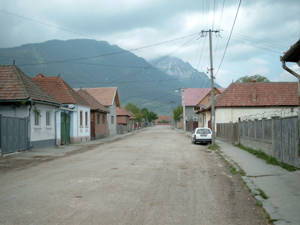
View from the CLCP office along a village street in Zarnesti,
Romania. In the background is the Piatra Craiului (King’s Stone)
Massive in the National Park that bears its name. Wolves roam
the forest, which sits just above the village’s cultivated fields.
In certain forests of central Europe where no significant populations of large predators exist, damage to trees from overbrowsing and bark peeling by wild ungulates is a serious problem. In addition to slowing the regeneration of new forest, overbrowsing can lead to problems such as soil erosion and the invasion of non-native plant species. A CLCP study found that browsing damage to trees in study areas in Bavaria (which has hunting but no large predators) was 10 times greater than in Romanian study areas. While many factors influence browsing damage by ungulates, large predators may help prevent overbrowsing in certain situations, especially when browsers could exacerbate transient problems caused by drought, fire, or heavy insect infestation. Natural predation tends to be a consistent, adaptable, and self-regulating part of the system that helps to maintain (or restore) the composition and dynamics of ecosystems.
Wolves also are expected to play a role in the future of a dilapidated factory town called Zarnesti, located in the “elbow” of the Carpathian Mountain chain. Zarnesti is at the center of recent efforts to realize economic benefits from the presence of wolves and other wildlife in the region. During the Communist era of the last century, the state planners decided that Zarnesti’s economy would be based on two large factories, a munitions plant and a paper mill. Thousands of workers and their families were forcibly relocated to the town from other parts of the country. In recent years, both factories have fallen on hard times, with the paper mill being all but shut down. The unemployment rate has soared to around 50 percent.
In order to tap the lucrative ecotourism market, the CLCP is working with Zarnesti to develop tourist-related infrastructure and businesses such as guesthouses, a horseback-riding center, a mountain-bike rental business, and a tour-guide training program. While a small beginning, the local revenue generated by tourists attracted to the region’s natural heritage – and especially the mysterious and elusive large carnivores – already exceeds the calculated costs of livestock and game predation and protection. However, as long as the people who realize the benefits are not the same people who bear the costs, controversy will remain about the calculation of this equation.
The case of the real Transylvanian wolves, as opposed to those so horrifically depicted in mythic images, demonstrates an ancient, yet evolving, coexistence between people and wolves, even under difficult economic circumstances rife with potential conflict. While the presence of wolves in Romania presents challenges, economic and ecological benefits are being realized. And conflicts over their presence are being resolved through increased understanding of wolf behavior and awareness of the needs of the people who share this remarkable landscape.
Is the Wolf at the Door?
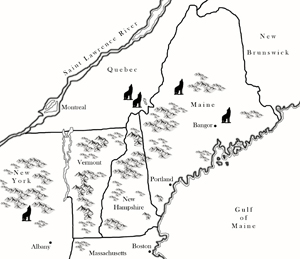
Wolves or evidence of wolves have been found at these places
in the Northeast, leading wildlife experts to believe they’re
on their way back.
For countless millennia, wolves were an integral feature of northern woodlands – not just the northern woodlands of the Northeast, but all northern woodlands. Populations of the adaptable canine spanned all the landmasses encircling the Arctic Sea. Here on the North American continent, wolves roamed the frozen tundra and boreal forests of Alaska and northern Canada, the open expanses of the central plains, the mountains of the West as far south as the arid uplands of Mexico, and the lush temperate forests of the East. Across the Bering Strait on the Eurasian landmass, they inhabited lands of similar features and climes: the Siberian tundra, the taiga of Russia, the vast steppes of central Asia, and the temperate forests that span the middle latitudes and cover much of Europe – ranging south into the deserts of the Middle East and the jungles of India.
Through the ages, wolves shared this diverse landscape of the northern third of the planet with another intelligent, social, and adaptable predator – a two-legged one that walked upright and could be either a deadly foe or, apparently, a cooperative ally. Through the evolutionary process, all of the various breeds of dogs in existence today are descendants of wolves that formed a symbiotic relationship with humans.
At some point in a long and complex relationship, most human attitudes about wolves came to be dominated by imagination and fear, and the wolf came to personify evil in myths and legends of medieval Europe. Among the early Europeans who emigrated to North America, these beliefs, along with a general desire to subdue all things wild, led to a ruthless and effective campaign to completely eradicate wolves from the landscape. The last wolves in New England were exterminated by the mid-nineteenth century, around the time that Bram Stoker penned Dracula – the popular horror novel that has helped to foster a mythological image of the Romanian region of Transylvania as a frightening abode of evil. Marauding wolves are a prominent feature of this image, which persists even to this day. By the early 1900s, eradication was essentially completed in the lower 48 contiguous states of the U.S., except for a small population of wolves that survived in northern Minnesota.
There is no definitive evidence that wolves have become re-established in the deep woods of the Northeast, although sporadic sightings and killings of lone wolves occur. Peggy Struhsacker, wolf team leader of the National Wildlife Federation, enumerated the following instances of wolves in the region:
When young wolves leave their home packs to seek new territory and a mate, they can disperse widely – as far as 500 miles. Wolf packs have been documented in the province of Quebec within 75 miles of the Maine border, and although the St. Lawrence Seaway and open agricultural lands lie in between, Struhsacker and many other experts believe it possible that a male and a female disperser will find each other somewhere in the North Woods, breed, give birth, and raise their young – establishing the first pack in the northeastern U.S. since their eradication. State and federal wildlife biologists are monitoring suitable habitat in the forests of northern New England and New York, and some private groups such as the National Wildlife Federation are actively searching for evidence that wolves have migrated into these areas.
Before they were eliminated, wolves were one of the Northern Forest’s “keystone” species – a top predator playing a key role in maintaining the composition and dynamics of the ecosystem – and it helped drive the evolution of wild ungulates such as deer and moose into the animals that they are today. Nevertheless, the acceptance of wolves back into the North Woods is controversial. Some people cherish wolves, recognizing their ecological and evolutionary role and seeing them as symbols of nature and wildness, and there are those who advocate helping the migration process along by actively relocating wolves into the region. Others vehemently oppose the presence of wolves, viewing them as competitors for wild game and a threat to domestic livestock and pets – and even people, though wild wolf attacks on humans are exceedingly rare. Experience elsewhere, including in the Upper Midwest, the Southwest, and the West, suggests that migrating or relocated wolves might be intentionally killed – regardless of the legal protections granted to the species.
In 1978, wolves were granted full protection throughout the contiguous U.S. under the Endangered Species Act (ESA). Because populations have recovered in certain areas of the northern Rocky Mountains and the upper Midwest (about five percent of their original range), in 2003 the federal government downlisted the gray wolf from “endangered” to “threatened” in most of the U.S. and more recently proposed removing them completely from federal ESA protection in all states east of the Dakotas. Without federal protection, individual states would have to decide both whether to confer protected status (subject to federal approval where wolves currently exist in Minnesota, Wisconsin, and Michigan, but not elsewhere) and whether to actively promote recovery of the species. However, as a result of two separate lawsuits by conservation groups, two U.S. District Courts in 2005 overturned the downlisting of gray wolf populations everywhere except Minnesota, and therefore any wolves that return to New England on their own are currently protected. The U.S. Fish and Wildlife Service has appealed these rulings.
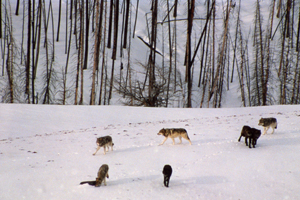
This aerial photo shows a wild Yellowstone wolf pack in winter.
Our understanding of the taxonomy and lineage of wolves here and around the world is complex and still evolving as genetic and fossil information continues to be gathered and analyzed. Current thinking by most experts designates a subspecies of the gray wolf, Canis lupus lycaon (known by various popular names, including eastern timber wolf) as the likely historical wolf of New England, and this is the same subspecies currently across the border in Canada. There is some evidence that New England was originally inhabited by the red wolf, Canis rufus, and some experts believe lupus lycaon and rufus should be classified together as the same species. The wolves of Transylvania are considered another subspecies of the gray wolf, Canis lupus lupus; regardless of the details of taxonomy, they are morphologically, behaviorally, and ecologically very similar to the wolves of eastern North America.
After the extermination of wolves in the northeastern U.S., their ecological niche became partially filled by coyotes, which have recently moved into the region to fill the void. In those areas of the western U.S. where other subspecies of Canis lupus have returned, coyotes have tended to be displaced. But lycaon wolves and coyotes are known to interbreed, and the ancestors of the eastern coyote picked up wolf genes as they migrated into the region. Eastern coyotes are larger than their more genetically pure western relatives, and they exhibit more behavioral and ecological tendencies of wolves, especially pack hunting and greater white-tailed deer predation. Meanwhile, the lycaon wolves of Ontario and Quebec possess some coyote genes, and they are smaller than the Canis lupus wolves that dwell to the west. Thus the distinction between coyotes and wolves has become somewhat blurred in eastern Canada and the northeastern U.S. To what extent returning wolves would displace, merge with, or coexist with coyotes is unclear; regardless, their return would likely have some ecological consequences – in particular, wolves are more likely than the eastern coyote to successfully prey on moose and beaver.
As the acceptance of wolves is debated, as legislators consider management plans, and as individuals living, working, recreating, and hunting in the woods of the Northeast make choices about whether to allow their presence, perhaps we can gain useful perspectives from other parts of the world regarding the co-existence of wolves and humans.


Discussion *